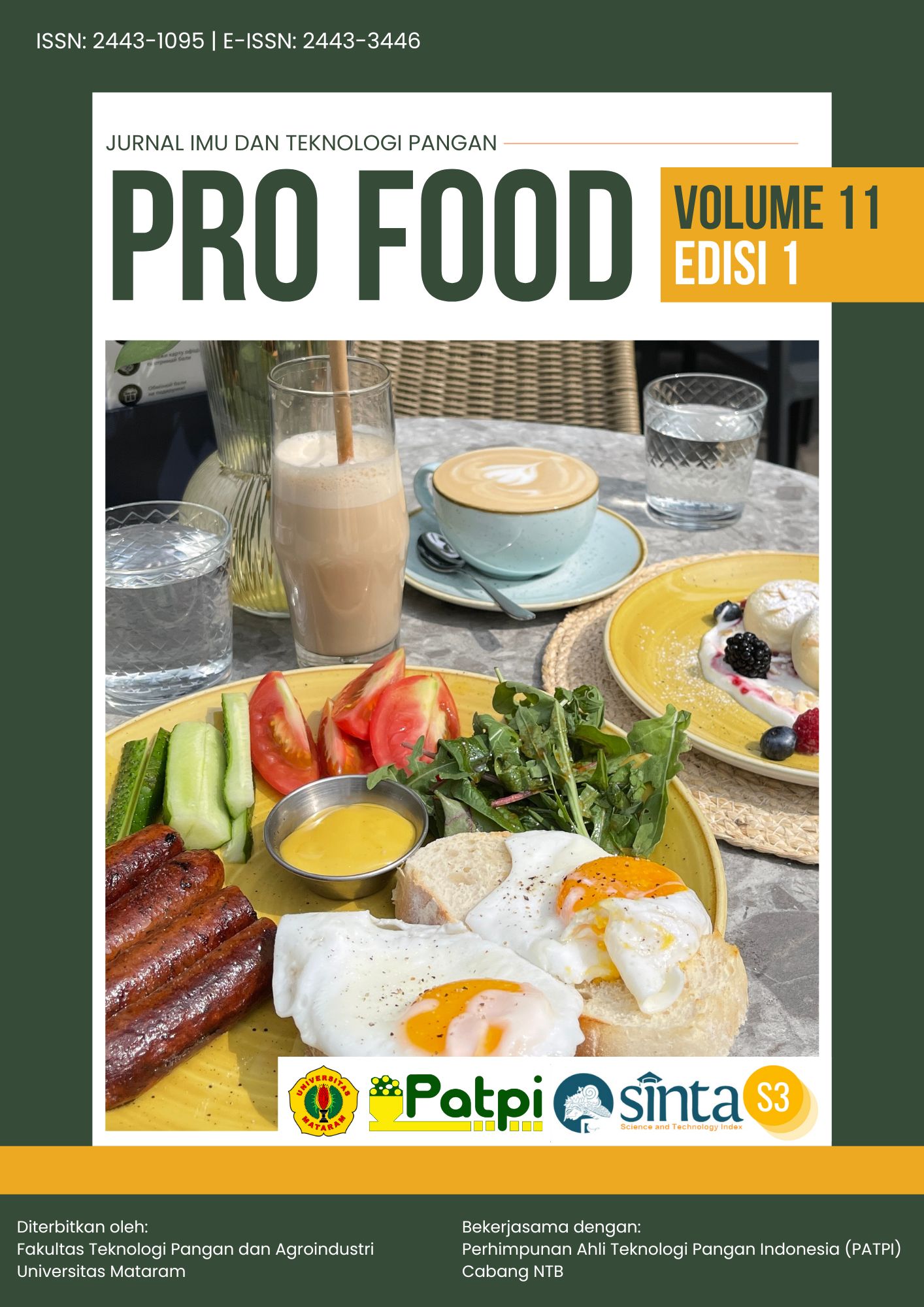Optimization of Cocoa (Theobroma cacao L) Bean Fermentation Time on Chocolate Bar Quality
Keywords:
Chocolate bars , cocoa beans, fat content, fermentation, sensory characteristicsAbstract
Fermentation is a critical stage in post-harvest processing of cocoa beans that affects the formation of precursors of the aroma and distinctive taste of chocolate. Fermentation of cocoa beans that is too fast causes the color of the cocoa to still be purple, does not have a distinctive aroma and is dominated by bitter and sour taste, while too long causes rancidity and an astringent aroma. This study aims to identify the best fermentation time to produce chocolate bars that are preferred by consumers, by analyzing the effect of variations in fermentation time on sensory characteristics (color, aroma, taste, and texture) and fat content of chocolate bars. This study used a Completely Randomized Design (CRD) with four fermentation time treatments (4,5,6, and 7 days), three replications, and post-hoc analysis of the Least Significant Difference (LSD). The results of this study indicate that the fermentation time can increase fat content with values ranging from 42.33% (A1) to 58.66% (A4). Sensory evaluation conducted by preference test showed a preference level of “rather like” to “like” in all treatments, with an average color ranging from 5.46-5.70, aroma ranging from 5.13-5.70, taste ranging from 4.50-5.73, and texture ranging from 5.40-5.56. Specifically, extended fermentation time can reduce the bitter taste, resulting in a more preferred chocolate bar. This study concluded that a fermentation time of 6 days is the optimal fermentation time to produce chocolate bars with high fat content and the most preferred color, aroma, taste, and texture characteristics.
References
Ariyanti, M. (2017). Karakteristik mutu biji kakao (Theobroma cacao L) dengan perlakuan waktu fermentasi berdasar SNI 2323-2008. Jurnal Industri Hasil Perkebunan, 12(1), 34–42. https://doi.org/10.33104/jihp.v12i1.2757.
Dahlan, S., Bait, Y., & Une, S. (2024). Pengaruh lama fermentasi terhadap hasil karakteristik akhir dark cokelat matcha. Jambura Journal of Food Technology, 6(1), 129–140. https://doi.org/10.37905/jjft.v6i1.26000.
Hapsari, O. A. (2023, November 1). Kakao Indonesia: produksi, tantangan dan peluang. Balai Pengelola Hasil Perakitan dan Modernisasi Pertanian. https://bisip.bsip.pertanian.go.id/berita/kakao-indonesia-produksi-tantangan-dan-peluang.
Ifmalinda, I., Saputra, E., & Cherie, D. (2023). Pengaruh suhu pengeringan terhadap mutu kakao (Theobroma cacao L.) varietas Klon BL 50 pasca fermentasi. Teknotan: Jurnal Industri Teknologi Pertanian, 17(2), 105–114. https://doi.org/10.24198/jt.vol17n2.4.
Lopes, G. G., Morgano, M. A., & Taniwaki, M. H. (2024). Advances in bean-to-bar chocolate production: microbiology, biochemistry, processing, and sensorial aspects. Brazilian Journal of Food Technology, 27, e2023133. https://doi.org/10.1590/1981-6723.13323.
Melo, T. S., Pires, T. C., Engelmann, J. V. P., Monteiro, A. L. O., Maciel, L. F., & Bispo, E. da S. (2021). Evaluation of the content of bioactive compounds in cocoa beans during the fermentation process. Journal of Food Science and Technology, 58(5), 1947–1957. https://doi.org/10.1007/s13197-020-04706-w.
Murtiningrum, M., Silamba, I., Sijabat, P., Paiki, S. N. P., & Sarungallo, Z. L. (2023). Chemical and organoleptic characteristics of cocoa powder from fermented and unfermented cocoa beans from Masni District and Sidey in Manokwari Regency. Indonesian Journal of Food Technology, 2(1), 67–80. https://doi.org/10.20884/1.ijft.2023.2.1.9083.
Nur’aeni, M. D. R. (2016). Kajian organoleptik dan fisiko kimia olahan cokelat rasa jahe dengan tempering dan tanpa tempering [Skripsi, Universitas Pasundan]. Repository Unpas.
Nurhayati, N., & Apriyanto, M. (2021). Sensory evaluation of chocolate bar production materials of dry cocoa seeds in various fermentation treatments. Czech Journal of Food Sciences, 39(1), 58–62. https://doi.org/10.17221/272/2020-CJFS.
Permata, A., & Hidayah, N. (2024). Analysis of the effect of fermentation duration on the organoleptic properties of dried cocoa beans (Theobroma cacao L.) at Nglanggeran Agricultural Technology Park. Journal of Halal Science and Research, 5(2), 182–190. https://doi.org/10.12928/jhsr.v5i2.9957.
Rachmatullah, D., Putri, D. N., Herianto, F. (2021). Karakteristik biji kakao hasil fermentasi dengan ukuran wadah berbeda. Jurnal Viabel Pertanian, 15(1), 32–44. https://doi.org/10.35457/viabel.v15i1.1409.
Rahmadewi, Y. M., & Darmadji, P. (2019). Evaluasi sensoris coklat batang dari biji kakao rakyat dengan kondisi fermentasi dan pengeringan yang berbeda. Jurnal Dunia Gizi, 2(1), 56–62. https://doi.org/10.33085/jdg.v2i1.4404.
Tarigan, E. B., & Iflah, T. (2018). Beberapa komponen fisikokimia kakao fermentasi dan non fermentasi. Jurnal Agroindustri Halal, 3(1), 048–062. https://doi.org/10.30997/jah.v3i1.687.











